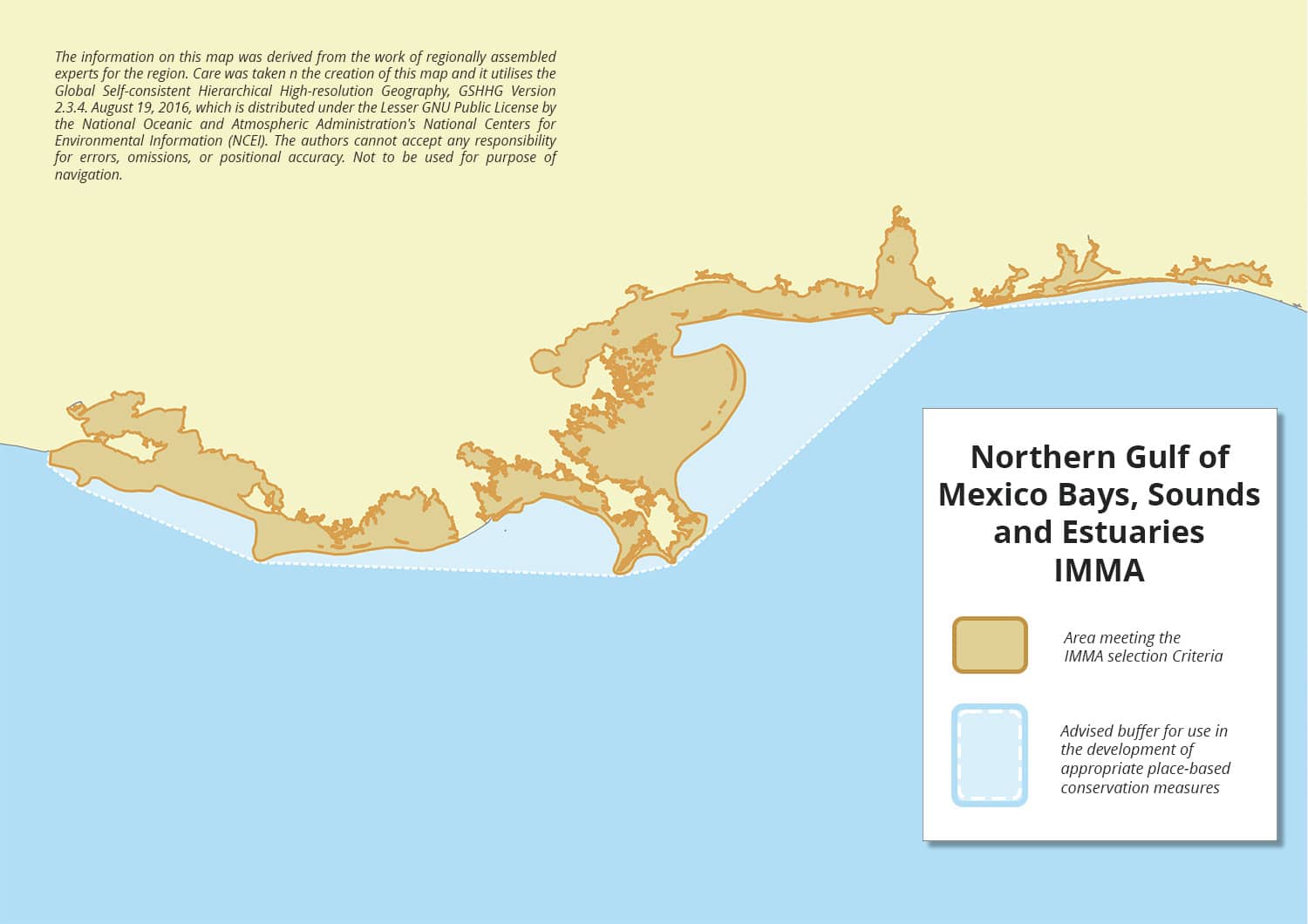Northern Gulf of Mexico Bays, Sounds and Estuaries IMMA
Size in Square Kilometres
17 497 km2
Qualifying Species and Criteria
Common bottlenose dolphin – Tursiops truncatus
Criterion B (1)
Download fact sheet
Summary
The IMMA encompasses inland and marine coastal waters up to the 5m depth contour between Vermilion Bay (Louisiana) in the west and Choctawhatchee Bay (Florida) in the east. It encompasses a diverse range of coastal and estuarine marine habitats, strongly influenced by freshwater inflow from rivers (including the Mississippi). The primary habitats present include salt marshes, seagrass meadows, tidal flats, oyster reefs, estuarine habitats and several barrier islands. Many of these bays and inlets host small resident populations of common bottlenose dolphins (Tursiops truncatus).
Description of Qualifying Criteria
Criterion B: Distribution and Abundance
Sub-criterion B1: Small and Resident Populations
This IMMA hosts a total of nine of the ‘bays, sounds, and estuaries’ common bottlenose dolphin (Tursiops truncatus) stocks that are recognised by NOAA: Vermilion Bay/West Cote Blanche/Atchafalaya Bay, Terrebonne-Timbalier Bay estuarine system, Barataria Bay estuarine system, Mississippi River Delta, Mobile Bay/Bonsecour Bay, Perdido Bay, Pensacola Bay/East Bay, and Choctawhatchee Bay (NMFS, 2021). It is estimated that 1,500 to 2,000 bottlenose dolphins are present in these systems with, however, some seasonal variation (NMFS, 2021). For most of these populations photo-identification, genetic and telemetry studies provide evidence that they are small and resident.
Miller (2003) concluded the common bottlenose dolphin population in the Barataria Basin in Louisiana was relatively closed, and Wells et al. (2017) documented long-term, year-round residency in Barataria Bay based on telemetry data. Hubard et al. (2004) reported sightings of dolphins in Mississippi Sound that were known from tagging efforts there 12–15 years prior; long-term residency in the same area was further documented by Mullin et al. (2017). For most common bottlenose dolphins in these systems, residents primarily occur in inshore and estuarine habitats, with limited movements in coastal waters. This is supported by genetic evidence, showing that estuarine (BSE) are genetically separate from coastal stocks of common bottlenose dolphins (Rosel et al., 2017).
Supporting Information
Hubard, C.W., K. Maze-Foley, K.D. Mullin and W.W. Schroeder. 2004. Seasonal abundance and site fidelity of bottlenose dolphins (Tursiops truncatus) in Mississippi Sound. Aquatic Mammals 30(2):299–310.
Miller, C. 2003. Abundance trends and environmental habitat usage patterns of bottlenose dolphins (Tursiops truncatus) in lower Barataria and Caminada Bays, Louisiana. Ph.D. thesis. Louisiana State University, Baton Rouge. 125 pp.
Mullin, K.D., T. McDonald, R.S. Wells, B.C. Balmer, T. Speakman, C. Sinclair, E.S. Zolman, F. Hornsby, S.M. McBride, K.A. Wilkinson and L.H. Schwacke. 2017. Density, abundance, survival, and ranging patterns of common bottlenose dolphins (Tursiops truncatus) in Mississippi Sound following the Deepwater Horizon oil spill. PLoS ONE 12(10):e0186265.
National Marine Fisheries Service, 2021. Common Bottlenose Dolphin (Tursiops truncatus truncatus): Northern Gulf of Mexico Bay, Sound, and Estuary Stocks. Marine Mammal Stock Assessment Reports by Species/Stock. https://www.fisheries.noaa.gov/s3/2023-08/Common-Bottlenose-Dolphin-Northern-Gulf-of-Mexico-Bay-Sound-and-Estuary-2022.pdf
Rosel, P.E., L.A. Wilcox, C. Sinclair, T.R. Speakman, M.C. Tumlin, J.A. Litz, and E.S. Zolman. 2017. Genetic assignment to stock of stranded common bottlenose dolphins in southeastern Louisiana after the Deepwater Horizon oil spill. Endangered Species Research 33:221–234.
Wells, R.S., L.H. Schwacke, T.K. Rowles, B.C. Balmer, E. Zolman, T. Speakman, F.I. Townsend, M.C. Tumlin, A. Barleycorn and K.A. Wilkinson. 2017. Ranging patterns of common bottlenose dolphins (Tursiops truncatus) in Barataria Bay, Louisiana, following the Deepwater Horizon oil spill. Endangered Species Research 33:159–180.
Downloads
Download the full account of the Northern Gulf of Mexico Bays, Sounds and Estuaries IMMA using the Fact Sheet button below:
To make a request to download the GIS Layer (shapefile) for the Northern Gulf of Mexico Bays, Sounds and Estuaries IMMA please complete the following Contact Form:


